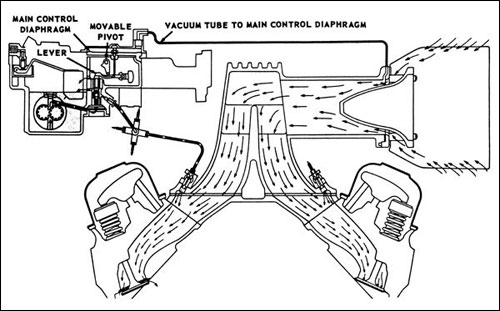Atomizing Fuel: Rochester Fuel Injection

Fitted to the first- and second-generation (C1 and C2) Corvette V8s, Rochester fuel injection was GM’s first foray beyond carburetion.
Hard on the heels of Mercedes’ fuel injection experiments across the Atlantic in the mid-’50s, the Rochester mechanical fuel injection system was less a counterpart to the German automaker’s racing-focused program and more an effort to enhance low-speed driveability in their high-performance Corvette sports car.
One of the primary issues was hood height. Perched atop the intake manifold surmounting a tall small-block Chevy V8, a carburetor and its air cleaner assembly would fit under the low, sloping hood of a sports car only if the intake runners were relatively short. And while shorter, wider runners are ideal for airflow at high rpm, they’re not best for engine efficiency and cylinder filling at low engine speeds, compromising the low-rpm, off-the-line “punch” of the Corvette’s V8. Longer, narrower runners (and a consequently taller intake manifold) are desirable during the engine’s warm-up period too, when the manifold heats unevenly and has the potential to develop “hot spots” that affect individual cylinder operation.

GM’s solution to these conflicting requirements was to task one of their prime subcontactors—Rochester—with the development of a mechanical fuel injection system. First fitted to a ‘Vette in 1957, the resultant system wasn’t nearly as dependent a carb on intake runner length and profile. It solved all the issues, giving the engine a smooth warm-up sequence, muscular low-rpm behavior, a decent top end and allowed the use of a shorter intake manifold for low hood height.
Reminiscent of Bosch’s later K-Jetronic system, the Rochester’s injectors sprayed continuously into the intake ports upstream of the valves. The higher fuel pressure required over a carb was delivered by a cable-driven mechanical pump, and metering was controlled by a movable plate situated in the intake manifold whose position varied with airflow, and thus engine load. The plate’s movement sent a vacuum signal to the fuel pressure regulator, which controlled the amount of fuel flowing to the injectors.

It was a remarkably simple system, with only a few downsides, among them cost, as the lower production volumes of the Rochester fuel injection system couldn’t benefit from economies of scale. Also, fuel economy compared to contemporary carbs was poor (not that it really mattered much in the ’50s and ’60s) and all the components had to be adjusted with precision for the system to function properly, so it required some specialized knowledge and tools. Aftermarket hot-rodders found its ultimate performance potential poor as well, seeing as how there was an accepted body of knowledge about how to tune carbs for performance, and aftermarket injectors and high-flow intakes were unheard of during the Rochester’s heyday.
Overall, though, it’s a neat system, and its adoption way back in the late ’50s just goes to show that GM is frequently much more forward-thinking than I give them credit for.
Editor’s note: This post is part of an ongoing series highlighting various obsolescent methods of fuel delivery. Read the other installments here:





